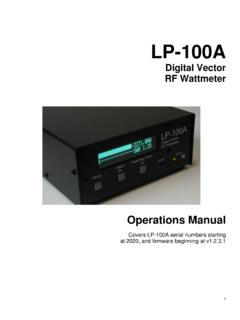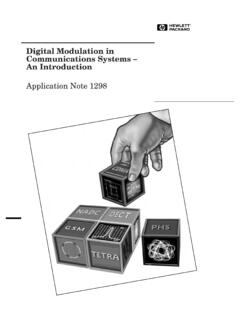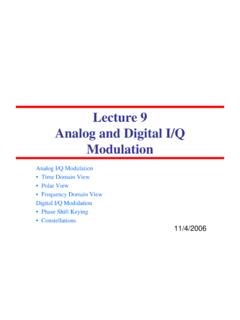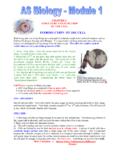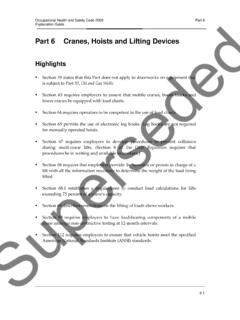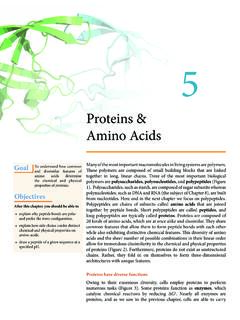Transcription of Basic Principles of Chromatography
1 27c h a p t e rBasic Principlesof ChromatographyBaraem Ismail Department of Food Science and Nutrition, University of Minnesota,St. Paul, MN 55108-6099, Suzanne NielsenDepartment of Food Science, Purdue University,West Lafayette, IN 47907-2009, Batch Continuous Countercurrent Historical General Nielsen,Food Analysis,Food Science Texts Series, DOI ,c Springer Science+Business Media, LLC 2010473474 Part V Gas Liquid Paper Factors Column Supercritical Fluid Physicochemical Principles of Adsorption (Liquid Solid) Partition (Liquid Liquid) Coated Bonded Ion-Exchange Size-Exclusion Affinity Analysis of Chromatographic Separation and Developing a Column Qualitative Quantitative Study References498 Chapter 27 Basic Principles of INTRODUCTIONC hromatography has a great impact on all areas ofanalysis and, therefore, on the progress of sciencein general.
2 Chromatography differs from other meth-ods of separation in that a wide variety of materials,equipment, and techniques can be used. [Readers arereferred to references (1 19) for general and specificinformation on Chromatography .]. This chapter willfocus on the Principles of Chromatography , mainlyliquid Chromatography (LC). Detailed Principles andapplications ofgas Chromatography (GC) will bediscussed in Chap. 29. In view of its widespreaduse and applications, high-performance liquid chro-matography (HPLC) will be discussed in a separatechapter (Chap. 28). The general Principles of extrac-tion are first described as a basis for EXTRACTIONIn its simplest form, extraction refers to the trans-fer of a solute from one liquid phase to in myriad forms is integral to food anal-ysis whether used for preliminary sample cleanup,concentration of the component of interest, or as theactual means of analysis.
3 Extractions may be catego-rized asbatch,continuous, orcountercurrentpro-cesses. (Various extraction procedures are discussed indetail in other chapters: traditional solvent extractionin ,18, and 29; accelerated solvent extractionin ; solid-phase extraction in ; and solid-phase microextraction and microwave-assisted solvent extraction in ). Batch ExtractionInbatch extractionthe solute is extracted from one sol-vent by shaking it with a second, immiscible solutepartitions, or distributes, itself between thetwo phases and, when equilibrium has been reached,thepartition coefficient,K, is a of solute in phase lConcentration of solute in phase 2[1]After shaking, the phases are allowed to separate,and the layer containing the desired constituent isremoved, for example, in a separatory funnel.
4 Inbatch extraction, it is often difficult to obtain a cleanseparation of phases, owing to emulsion , partition implies that a single extraction isusually Continuous ExtractionContinuous liquid liquid extractionrequires specialapparatus, but is more efficient than batch separa-tion. One example is the use of a Soxhlet extractor forextracting materials from solids. Solvent is recycled sothat the solid is repeatedly extracted with fresh sol-vent. Other pieces of equipment have been designedfor the continuous extraction of substances from liq-uids, and different extractors are used for solvents thatare heavier or lighter than Countercurrent ExtractionCountercurrent distributionrefers to a serial extrac-tion process.
5 It separates two or more solutes with dif-ferent partition coefficients from each other by a seriesof partitions between two immiscible liquid liquid partition Chromatography ( ),also known as countercurrent Chromatography , is adirect extension of countercurrent extraction. Yearsago the countercurrent extraction was done with a Craig apparatus consisting of a series of glass tubesdesigned such that the lighter liquid phase (mobilephase) was transferred from one tube to the next,while the heavy phase (stationary phase) remainedin the first tube (4). The liquid liquid extractions tookplace simultaneously in all tubes of the apparatus,which was usually driven electromechanically.
6 Eachtube in which a complete equilibration took placecorresponded to one theoretical plate of the chromato-graphic column (refer to Sect. ). The greaterthe difference in thepartition coefficientsof varioussubstances, the better was the separation. A muchlarger number of tubes was required to separate mix-tures of substances with close partition coefficients,which made this type of countercurrent extractionvery tedious. Modernliquid liquid partition chro-matography( ) that developed from thisconcept is much more efficient and Historical PerspectiveModern Chromatography originated in the late nine-teenth and early twentieth centuries from independentwork by David T.
7 Day, a distinguished Americangeologist and mining engineer, and Mikhail Tsvet,a Russian botanist. Day developed procedures forfractionating crude petroleum by passing it throughFuller s earth, and Tsvet used a column packed withchalk to separate leaf pigments into colored V ChromatographyBecause Tsvet recognized and correctly interpretedthe chromatographic processes and named the phe-nomenonchromatography, he is generally creditedwith its languishing in oblivion for years, chro-matography began to evolve in the 1940s due to thedevelopment of column partition Chromatography byMartin and Synge and the invention of paper chro-matography.
8 The first publication on GC appeared in1952. By the late 1960s, GC, because of its impor-tance to the petroleum industry, had developed intoa sophisticated instrumental technique, which wasthe first instrumental Chromatography to be availablecommercially. Since early applications in the mid-1960s, HPLC, profiting from the theoretical and instru-mental advances of GC, has extended the area ofliquid Chromatography into an equally sophisticatedand useful method. SFC, first demonstrated in 1962,is finally gaining popularity. Modern chromatographictechniques, including automated systems, are widelyutilized in the characterization and quality control offood raw materials and food General TerminologyChromatographyis a general term applied to a widevariety of separation techniques based on the parti-tioning or distribution of a sample (solute) betweena moving or mobile phase and a fixed or stationaryphase.
9 Chromatography may be viewed as a seriesof equilibrations between the mobile and stationaryphase. The relative interaction of a solute with thesetwo phases is described by thepartition(K)ordistri-bution(D)coeffic ient(ratio of concentration of solutein stationary phase to concentration of solute in mobilephase). The mobile phase may be either a gas (GC) orliquid (LC) or a supercritical fluid (SFC). The station-ary phase may be a liquid or, more usually, a solid. Thefield of Chromatography can be subdivided accordingto the various techniques applied (Fig27-1), or accord-ing to the physicochemical Principles involved in theseparation.
10 Table27-1summarizes some of the chro-matographic procedures or methods that have beendeveloped on the basis of different mobile stationaryphase combinations. Inasmuch as the nature of inter-actions between solute molecules and the mobile orstationary phases differ, these methods have the abilityto separate different kinds of molecules. (The reader isurged to review Table27-1again after having read thischapter.) Gas ChromatographyGas chromatographyis a column chromatographytechnique, in which the mobile phase is gas and thestationary phase is either an immobilized liquid or asolid packed in a closed tube.
